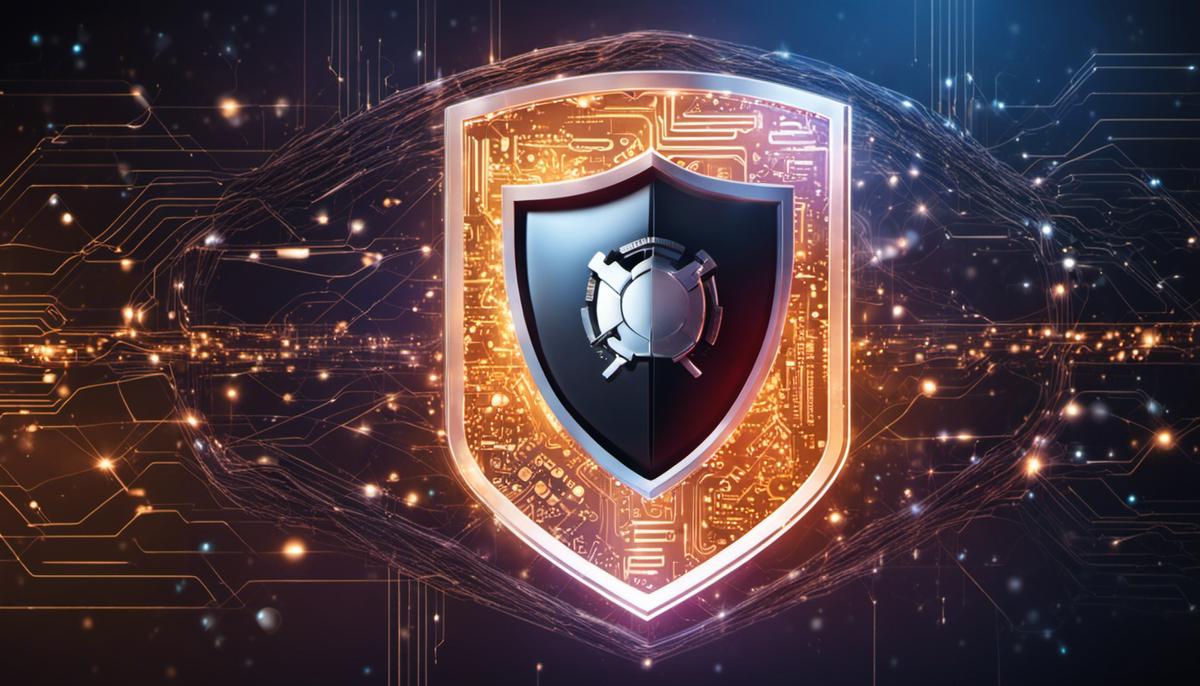As we navigate through the digital age, harnessing the power offered by technology, the cri de coeur for comprehensive cybersecurity knowledge becomes increasingly imperative. We exist on a frontier where the landscape of cyber threats is dynamically evolving, requiring us to be equipped with current knowledge and understanding of these emergent threats and their potential impact on both personal and professional realms. This essay probes further into the variegated techniques to mitigate these security risks, highlighting the burgeoning role of artificial intelligence in identifying and countering cyber threats. We will also delve into the significance of cyber security education, a critical tool in the mitigation of cyber risks.
The Evolving Landscape of Cyber Threats
TITLE: The Current Landscape and Evolution of Cyber Threats
In the realm of technology, staying ahead of the curve oftentimes means navigating a digital minefield filled with stealthy, concerning cyber threats. The increasingly interconnected world, despite its multitude of wonders, has given rise to sophisticated, high-stake cybersecurity issues.
As we dive deep into 2022, reflecting on the complex past while anticipating an evolving future is a pragmatic exercise worth exploring.
Today’s digital landscape is teeming with cyber threats that threaten personal, corporate, and national security daily. From the potent Trojan horses, seemingly harmless yet notorious for their deceptive nature, to worms that seep into any vulnerability within the system, the pantheon of threats is exhaustive and relentless.
The crown jewel of present cyber threats is arguably ransomware. By encrypting data and demanding a ransom for its release, these attacks can cripple vast networks, causing massive financial and operational disruptions. Multiple high-profile incidents have instantiated this threat – consider the colonial pipeline incident that jolted the American infrastructure or the JBS USA assault that rampaged the global meat supply.
Data breaches also persist, turning personal information into a lucrative commodity for nefarious intentions. By infiltrating protective barriers, cybercriminals siphon confidential information, leading to troubling occurrences like identity theft and fraud.
Moreover, one cannot overlook the lurking menace of DDoS attacks. With the intent to overwhelm and crash servers, these attacks disrupt normal functioning using a flood of internet traffic.
The future of cyber threats, while not entirely predictable, is heading towards a more sophisticated spectrum driven by advancements in Artificial Intelligence (AI) and automation capabilities.
AI, with its ability to expediently identify patterns and vulnerabilities, can empower cyberattacks. Cybercriminals can leverage AI to automate entry-point identification, making their attacks more swift and effective. In a similar vein, machine learning can be harnessed to mimic user behavior, making spear phishing campaigns more convincing and, thus, formidable.
Quantum computing, another potential game-changer, could turn current methods of encryption obsolete. If leveraged maliciously, it could decrypt crucial data, giving cybercriminals unbridled access to sensitive material.
In spite of the increasing complexity, it’s not all doom and gloom. The same technological advancements aiding cyber threats provide tools for cyber defense, too. AI and machine learning can augment threat detection, automation can quickly patch vulnerabilities, and quantum cryptography promises invulnerable data protection. These advancements constitute the vital counterforce that safeguards our digital ecosystem.
Grasping the evolving landscape of cyber threats ensures the continued safety of valuable data. By forging a symbiotic relationship with technology and understanding its potential pitfalls as much as its invaluable merits, we can confidently stride towards a future that is secure, sustainable, and driven by technological transformation.

Defensive Strategies in Cyber Security
Taking from where we left off, let’s dive into unchartered territories of cyber-threat mitigation.
Today’s technology-driven world is an environment of continual evolution. With every new possibility that emerges, individuals and organizations are faced with the task of matching fresh opportunities with corresponding cyber threat deterrents.
An effective shield against cyber threats is maintaining a robust password strategy. A strong password is the equivalent of a sturdy padlock on the door to your online world – a world where hackers are eager to enter.
Multi-factor authentication further strengthens this defense by adding another layer to the security wall. This is not just a password; it’s a dynamic code that changes frequently and can be sent to a preset mobile device as an SMS message or accessed via an app.
Moreover, the concept of zero-trust architecture has gained momentum due to its different approach toward security. Forget the notion of ‘trust but verify’; now, it’s ‘never trust, always verify’. Even if you’re on your private network, Zero Trust doesn’t take any connection at face value. Everything — and everyone — is treated as a possible risk zone or vector.
To establish a more robust defense against cyber threats, organizations should consider deploying automated systems that secure endpoints and consistently monitor and mitigate threats. Endpoint detection and response (EDR) tools offer continual surveillance and analysis, identifying potential vulnerabilities and addressing them before the bad actors can exploit them.
In addition, implementing a strong defense mechanism might also involve constructing ‘honeypots’ – decoy systems or data to confuse or delay cyber attackers, leading them away from valuable assets. Think of them as a high-tech version of a scarecrow.
User training cannot be emphasized enough when it comes to defensive strategies. Even the most high-tech, bulletproof cyber defenses can crumble due to human error. Organizations must commit to ongoing employee education about the latest threats and how to identify and respond to them. This measure, although it seems simple, has proven to be remarkably effective.
On a broader scale, international cybersecurity standards such as ISO 27001 can provide a useful framework to enhance cyber resilience. This includes systematic approaches to managing sensitive data, ensuring it remains secure with a risk management process, and giving assurance to company stakeholders and customers.
But, even with the best plans in place, it is crucial to remember that cyber defense is not a static discipline. It must evolve alongside, and ideally ahead of, the cyber threats it seeks to mitigate. It’s not about creating a fortress but more like piloting an agile ship in the changing winds and currents of the digital sea.
Lastly, cybersecurity is a collective struggle. The public and private sectors must collaborate to share information on emerging threats and response strategies. Organizations should work with government agencies, participate in industry groups, and share threat intelligence. Through unity, the global community can present a more potent defense against cyber threats. Stay vigilant, stay safe.

The Role of Artificial Intelligence in Cyber Security
Building on the foundation of this enlightening exploration into the world of cyber threats and much-needed defenses, let us delve deeper into how artificial intelligence (AI) is reshaping cybersecurity practices and its prospective future ramifications.
AI, with its uncanny ability to predict and identify threats, is enhancing our response to various cyber threats. AI’s predictive analytics, for instance, can be used to identify patterns that humans might overlook. Through machine learning algorithms, it’s possible to detect anomalies and isolate them before they damage the system. This predictive prowess enables us to move from a reactive, incident-response mindset to a proactive, threat-hunting approach.
Adaptive security is another innovative solution that AI offers. Given the evolving nature of cyber threats, static defenses might not cut it anymore. AI-based adaptive security systems are able to learn from previous attacks, sharpening their ability to predict, identify, and block incoming threats. Here, AI behaves like our immune system, learning and adapting to newer strains of viruses, making our defenses more resilient and less susceptible to breaches.
Robotics Process Automation (RPA) is another cog in the machine of AI-driven cybersecurity. By automating certain tasks, RPA not only increases operational efficiency but also reduces the risk of human error, a prominent cause of security breaches. RPA can also gather intelligence about various threats, contributing to the prevention of future attacks.
Natural Language Processing (NLP), a subfield of AI, can be utilized to decode the hidden meanings in phishing emails, identifying potential threats that might be hidden in plain view. The ability of AI to understand human language, contributing to enhanced security, is certainly an exciting prospect.
Yet, while we sing praises of AI, it’s also important to address the dual-use nature of these technologies. Just as we can utilize AI for defense, so can adversaries for offenses, like creating more sophisticated malware or carrying out more efficient attacks. Hence, there’s a continuous, collective responsibility to upgrade and adapt, maintaining a few steps ahead of malevolent advances.
Artificial intelligence is playing an increasingly integral role in cyber defense strategies, especially as cyber threats continue to evolve at an alarming pace. While AI might present new challenges in the hands of attackers, it also offers unprecedented solutions for defenders. It’s a tool in our arsenal and the weapon of our adversary. This paradox underscores the need for continuous learning, upgrading, and innovating our cyber defenses. Cybersecurity is no longer a field that can be won in isolation. It requires an ecosystem approach based on collaboration and shared intelligence to stay ahead of the curve.
In this era of digital dependency, the battle lines are clearly drawn. The war of AI supremacy in the field of cybersecurity is inevitable. Whichever side learns, adapts, and innovates faster will most likely come out on top.

Importance of Cyber Security Education
Indeed, the game of cybersecurity reveals a stark reality – the cybercriminals don’t need to be right every time, while the guardians of cyberspace hardly have any margin for error. With such tension comes the critical question – how can we incorporate better cybersecurity education to strike a smarter, more effective balance?
Incorporating real-world scenarios and case studies into cybersecurity education can augment the general understanding of these complex issues. It’s like tasting a spicy Mexican dish for the first time. Until you experience the punch of a habanero, reading about Scoville scales will remain an abstract concept. Likewise, dissecting real breach incidents, studying their modus operandi, the execution flaws and the recovery efforts can reinforce learning and comprehension better than hypothetical situations.
Gamifying the cybersecurity education process can also be leveraged. The addictive nature of games can be sculpted into an engaging cybersecurity-connected experience. Interactive virtual environments can simulate real-world cyber threat encounters, letting learners grapple with attacks, strategize, and respond, thus enabling them to learn hands-on.
It’s also important to not just teach how to protect but also how to hack ethically. This may sound counterintuitive, but understanding the ethos of a hacker can better orient defenses. With such education, it’s about embracing an attacker’s perspective to fortify one’s own marketing strategy – know your enemy, in short.
Another major avenue for expanding cybersecurity horizons lies in integrating cross-disciplinary studies. Apart from tech-specific aspects like networking, programming, or computer architecture, the curriculum can include elements from fields like sociology or psychology to understand the human facet of cybersecurity. Ethical, legal, and policy issues around cybersecurity can also be incorporated into the study, nurturing a generation of well-rounded cyber professionals.
Additionally, a push towards encouraging a more diverse student body in cybersecurity education can lend different perspectives, leading to more innovative solutions to combat evolving threats. Traditionally male-dominated, injecting greater gender diversity and persons from different cultural backgrounds can challenge the conventional ways of thinking.
Pursuing robust Cybersecurity education is not only important, it’s becoming more of a necessity each day. The digital world is entangled in the real world more than ever before, and the implications are far-reaching. With more proactive, comprehensive, and innovative methods of education, we can spur the development of a generation that’s more cyber-conscious, competent, and vigilant, ready to guard our digital frontiers against the evolving tides of cyber threats. The war against cybercrime is unending, but with the right education, the battle is half won.

Moving forward, it is essential to foster a cyber-secure culture ingrained with the importance of staying abreast of the latest threats and preventative measures. Increased awareness in identifying threats, implementing best practices, and leveraging cutting-edge technologies such as AI and Machine learning can significantly reduce the risk of cyber attacks. This goes beyond the technical aspects, encompassing an educational perspective that empowers individuals and organizations with the necessary knowledge to navigate the online world safely. It’s no longer an option but a necessity in a world where digital realms are fast becoming intricate parts of our lives.
